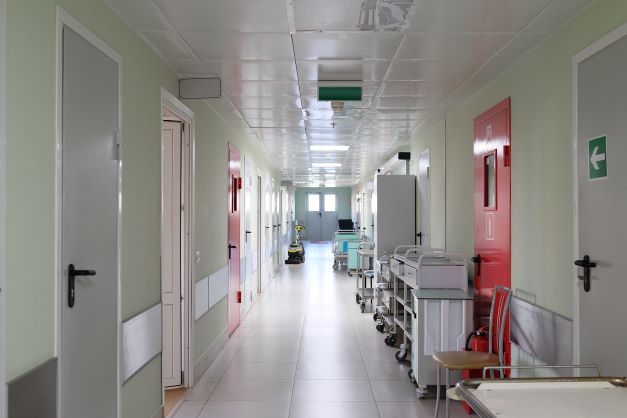Our newsletter series, Observations from the Field would not be complete if we did not include an article on the Environment of Care and Life Safety findings being cited both during official surveys and commonly found during our mock surveys at organizations. Findings in these two areas often trigger condition level findings in addition to appearing in the higher risk/ more pervasive categories used by accrediting organizations.
Sadly, as you read through these findings, very few are new to the list.
Corridor Clutter
Regulatory and Accrediting Organizations consider any piece of equipment as stationary if it has not been moved within the last 30 minutes. Exceptions to this rule include Crash Carts, Patient Care Carts, and other patient related equipment such as patient lift equipment provided that at least 5 feet of the corridor remains clear AND the organization’s fire plan addresses how the equipment will be managed during a fire or other emergency. The occurrence of corridor clutter is often accompanied by blocked corridors or hallways, blocked fire exits along with blocked medical gas shut-offs, electrical panels and fire pull stations. Please remember that a fire egress is considered blocked if the route to be traveled outside of the organization is not cleared of snow and/or ice.
Organizations should ensure that assessing the moving of patient care equipment that is properly located in the hallway is properly relocated during fire drills by including this on their fire drill critique tool.
Corridor Clutter vs. Furniture in Hallways
Corridor clutter and furniture in hallways is not assessed using the same criteria. Furniture is only permitted when:
- The full width of the corridor is at least 8 feet in width
- Placement of the furniture does not restrict the corridor to less than 6 feet in width
- The furniture is located in a fully smoke-detected location
- The furniture is attached to the wall and all furniture is located only on one side of the corridor.
There are also some additional criteria related to the size of the furniture. Organizations need to work closely with their Life Safety expert to ensure the placement of furniture is in compliance with all requirements.
Fire Door Assembly Maintenance
Typical findings in this area are related to painted labels/plates on the doors, gaps exceeding the allowable limit, incompatible door closure devices and non-latching door hardware. Occasionally, annual testing and inspection of the fire door assemblies is cited, but this finding seems to be declining thanks to technology that allows us to schedule this type of maintenance work.
Many organizations that we encounter these days will outsource painting to a specific vendor. Ensuring that the vendor understands the need to not paint over these essential labels can be accomplished by including such notice within the contract or purchase order and potentially withholding payment when breeches in the process are identified. While this may require an employee be assigned to inspect the work upon completion, this is certainly more effective than having to either deploy staff to remove the paint or pay additional monies to someone else to fix a problem that could have been avoided.
We would also encourage organizations to include monitoring for this on their Environmental Rounds tool.
Air Pressure Relationships
An area that was getting attention prior to the pandemic, and rose quickly to an area of concern during the pandemic is air pressure relationships. Findings related to the positive and negative airflow relationships are common and cross score into Infection Prevention and Control.
The Famous Catch-All
For those of you with long-time exposure to the EC requirements, you may remember the requirement/standard that obligates organizations to provide care in a safe, appropriate environment. Prior to the separation of environmental findings related to ligature risk, this area was the top scoring area related to the environment. While the separation of ligature risk related findings has reduced the number of findings, there are still significant findings that score here along with cross-scoring into the Infection Prevention and Control category. Common findings in this category include broken cabinetry, broken furniture, torn or deteriorated upholstery and general disarray of an area.
Fire Drills
Organizations continue to receive citations for sponsoring fire drills based upon a predictable schedule. Organizations that are classified as healthcare and ambulatory occupancies must conduct fire drills once per quarter per shift. Once per quarter per shift is interpreted to mean every 3 months with a permissible range of 10 days early and up to 10 days later than the actual due date. Business occupancies are required to drill once every 12 months. This is calculated based upon the last drill date.
Where most organizations falter is in the calculation of the timing. Drills should be at least over an hour apart. This means if your drill was at 3:00 pm; your next drill needs to be BEFORE 2pm or AFTER 4 pm. Drill times should not be repeated within the same calendar year. Following this type of a cadence for your drills will support the expectation that drills occur randomly.
Drill expectations also consider the potential impact on patients when drills need to occur during evening/night hours. To avoid patient upset, drills performed between 9pm and 6am can be performed without the audible alarm triggering the event. Organizations are permitted to establish an alternative method to alert staff of the drill.
To learn more about Environment of Care and Life Safety contact the C&A team at 704-573-4535 or email us at info@courtemanche-assocs.com.


